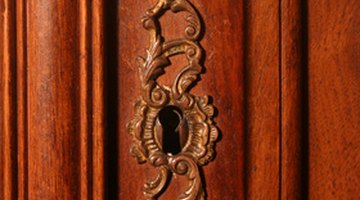How to Stencil Hitchcock Style Furniture
Intricate, hand stenciled designs, gold banding on turned legs, yellow ocher pin striping and bronze powder coated finishes signify the distinctive look of Hitchcock chairs. Founded by Lambert Hitchcock in the early 1800s, The Hitchcock Chair Company produced characteristic hand stenciled furniture for almost two centuries. Four years after the company’s demise in 2006, a local Connecticut antique shop called Still River Antiques bought the name, plans and artwork to continue the Hitchcock furniture legacy. Recreating the distinguished look of Hitchcock-style stenciling on furniture pieces requires a steady hand, concentration and attention to detail.

Step 1
Research the Hitchcock Chair Company archives to identify the particular stencil design you want to recreate. Cornucopias with fruit, flowers and butterflies are all common historic Hitchcock designs. Most of Hitchcock's pieces were painted black or dark green and were decorated by a process using brass stencils and rubbing a bronzing powder into a still-sticky top coat to achieve a luster effect. Pinstriping was achieved with yellow ocher paint, and gold leaf and paint was reserved for the banding on the legs of chairs.
Step 2
Find a source of suitable brass stencils. Occasionally, original Hitchcock stencils appear at auctions and estate sales. Craft stores and online stencil dealers also have suitable stencils with the appropriate subject matter or you can even commission custom stencils.
Step 3
Remove all hardware if possible or smooth petroleum jelly over it prior to painting to protect the hardware from the paint application.
Step 4
Prepare your piece of furniture for painting and stenciling to achieve the best result possible. Sand the wood lightly with a fine-grade sandpaper, following the direction of the grain.
Step 5
Prime your piece with a wood primer to ensure that the new paint adheres well to the surface. Allow the primer to dry thoroughly before doing any further work.
Step 6
Select a water-based paint in black or green for the base coat. Use acrylic or latex stencil paints in the appropriate colors for the chosen design. Use yellow ocher for pin striping and gold for any banding. Include bronzing powder and varnish in your purchase.
Step 7
Apply two coats of the base color to ensure even and smooth coverage of your Hitchcock inspired piece. Allow the paint to dry thoroughly after each coat.
Step 8
Attach your stencil in position with masking tape. Carefully apply your paints. Use paint sparingly; you don't want paint to bleed under the stencil. You can repeat the process and build up color far more easily than you can remove unwanted paint.
Make sure each color is dry before starting on the next, unless you want to blend colors as you go. Having carefully researched and studied Hitchcock originals, you will have a good idea of the effect you want to create. You may also find that practicing techniques on a scrap piece of wood before starting on your furniture piece is a useful exercise.
Step 9
Use masking tape to create Hitchcock's signature pinstripes. Ensure that your taped lines are straight. Paint them in with yellow ocher and leave to dry.
Once you are satisfied with the pattern you have stenciled and the pinstriping effect, varnish your piece.
Step 10
Apply bronzing powder while the varnish is still slightly tacky. Make a small pad, the size of your fingertip, from a piece of velvet and dip it into the bronzing powder. Gently dab the bronzing powder onto the areas you want to bronze. Allow your bronzing and blotting dry completely.
Step 11
Apply a finishing coat of varnish over the completed piece. Allow it to dry and install it in the room of your choice, in a position where everyone can admire your Hitchcock-inspired handiwork.
References
Tips
- If your piece is particularly intricate and has layers of old paint on it, having it dipped and stripped is the quickest and most effective way of preparing it.
- The bronzing effect is a Hitchcock hallmark, and the technique takes some practice to achieve perfection.
- Depth and shading can be achieved by applying the powder more heavily in some areas. If you have excess powder in some areas, you can remove it by blotting with warm water and a soft brush
Warnings
- If you think the existing paint on your piece of furniture may be lead-based, do not attempt to sand it yourself, since the particles should not be inhaled. Take your piece of furniture to a wood-treatment specialist who will dip it and strip it safely for a small fee.
Writer Bio
Helen Harvey began her writing career in 1990 and has worked in journalism, writing, copy-editing and as a consultant. She has worked for world-class news sources including Reuters and the "Daily Express." She holds a Master of Arts in mass media communications from Cambridge University in the United Kingdom.
Photo Credits
- old furniture detail image by stassad from Fotolia.com
More Articles



